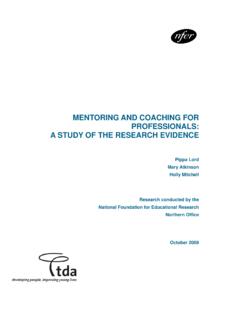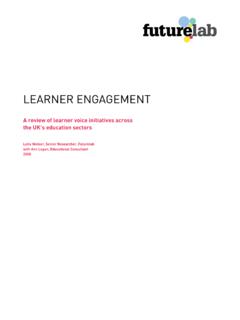Transcription of What leads to positive change in teaching practice? - NFER
1 The NFER Research ProgrammeWhat leads to positive change in teaching practice? Sarah Maughan, David Teeman and Rebekah WilsonDeveloping the Education Workforce Published in July, 2012 by the National Foundation for Educational Research, The Mere, Upton Park, Slough, Berkshire SL1 2DQ National Foundation for Educational Research 2012 Registered Charity No. 313392 How to cite this publication: Maughan, S., Teeman, D. and Wilson, R. (2012). what leads to positive change in teaching Practice (NFER Research Programme: Developing the Education Workforce).
2 Slough: NFER. Contents Executive summary 2 1. Introduction 7 Research questions 7 Strength and nature of the evidence base 8 Main themes 9 2. Leadership 10 Strategic leadership 10 Operational leadership 12 Distributive leadership 14 3. Planning and preparation 15 The strategic context 15 Involving and listening 16 Resources and systems 19 4. Types of practice development 21 Principles of practice development 21 Leadership 23 Collaboration 25 Research-led 27 5. Monitoring and evaluation 29 School-wide M&E 29 Teacher-led M&E 31 Student-involved M&E 32 6.
3 Discussion 33 Factors influencing change 33 Research gaps 34 References 37 what leads to positive change in teaching practice?? 1 Introducing The NFER Research Programme Developing the Education Workforce NFER has a worldwide reputation for excellence in research in education and children s services, built up over 65 years of working with a wide range of partners to produce independent evidence to inform change . As a charity, the Foundation exists to improve the education and life chances of learners through the provision of independent evidence aimed at influencing policy, informing practice in the learning environment and directly impacting learners.
4 To help achieve this, The NFER Research Programme was set up in 2011. Funded by NFER, it is developing partnerships with organisations and individuals who share our commitment to solving unanswered challenges young people face in education. The Programme targets key areas of education, highlighting gaps in existing evidence and conducting new research to provide the evidence to fill the gaps. Current areas of focus are From Education to Employment, Developing the Education Workforce and Innovation in Education. Over recent years, evidence from a number of major studies has begun to highlight how different education systems are doing in comparison to England and these studies have cast the education debate in this country in a new light.
5 Our school system needs to continually improve to meet the increasing global competition and this reform must be evidence based. The initial phase of our work in the Developing the Education Workforce strand is a pair of reports which map the current research into: what effective teaching looks like what causes teachers to change their teaching practice These reports offer a new perspective on the recent research in this area and identify the gaps for future research. A series of easy-to-use guides for practitioners, school leaders and local authorities based on the findings will also be available.
6 Sarah Maughan Research Director, NFER 2 what leads to positive change in teaching practice? Executive summary This report presents the findings of a study in which the NFER aims to map the key research evidence about what leads to positive change in teaching practice in schools. Teachers are at the heart of schools and the recent government White Paper states the most important factor in determining the effectiveness of a school system is the quality of its teachers (DfE, 2010, ). Our study aims to review the huge body of evidence that is available about the factors that lead to positive change in teaching practice, in order to draw conclusions about: the different forms of support that are most likely to encourage teachers to change their practice; if there is evidence about how changes in practice impact on student outcomes; and whether there are forms of support that represent particularly good value for money.
7 We also aim to highlight any inconsistencies or gaps in the evidence that may benefit from further research. Our report focuses primarily on literature from the UK and abroad, published in English, dating from 2006 to ensure a timely evidence base. However, where there are gaps in evidence that could be filled by high profile earlier literature, these are drawn on for completeness of discussions. We reviewed 132 items of literature, and selected 49 of these for the second stage of review at which we considered them in more detail. Sixteen items were then selected for inclusion in the final review.
8 Following the initial study, comments were collected on the draft report from experts in the field. These comments led to amendments to the report as well as the inclusion of additional studies. Five studies were added at this stage. Key findings Our findings have been grouped into four themes: leadership; planning and preparation; practice development; and monitoring and evaluation (M&E). Leadership This was the first theme which emerged from our review and we found that positive change requires strong leadership. Three different leadership practices emerged: strategic, operational and distributive.
9 Taking the first, it was often the vision and high expectations of an effective leader that inspired teachers to change aspects of their working practices . It was also important for leaders to create the right climate for change , as included in our operational label. A third practice is distributed leadership referring to the sharing of leadership responsibilities across an organisation. what leads to positive change in teaching practice?? 3 Strategic leadership: the vision of school leaders was found to inspire teachers to change their practice in a number of reports.
10 For this to work well the leadership should: set out a clear and realistic vision it is important for teachers to understand what the aim of an innovation is if they are to contribute to achieving that aim be based on a well-evidenced rationale, and also adapted to the local context allow teachers to take ownership of the issue, whilst also providing guidance and support where it is needed. Operational leadership: in addition to a convincing vision, it is also necessary to be able to realise this change practically, by defining the activities that are required.










